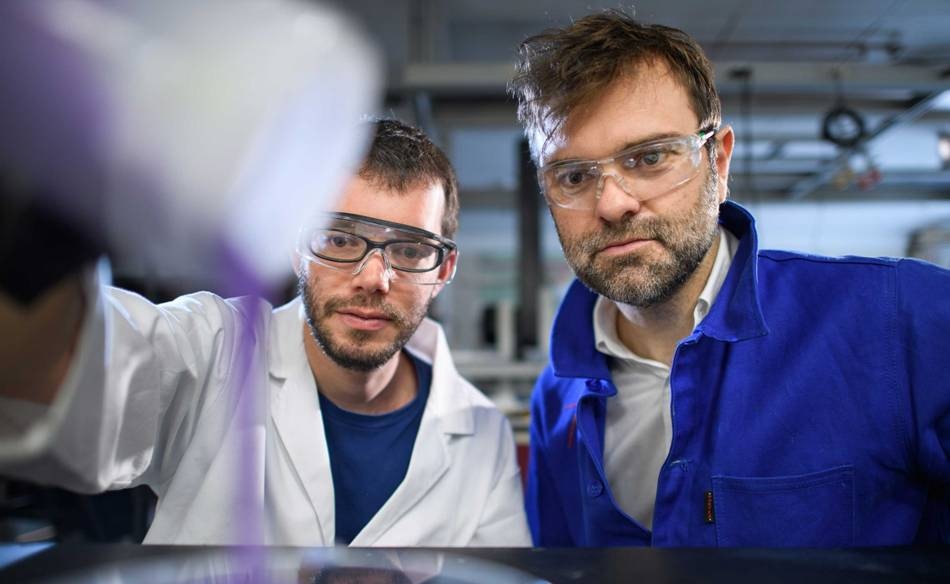Nov 9 2018
Generally, popping the top on house paint draws people to look what is within the can; however, researchers at Princeton University have turned their gaze upward, to the lid’s underside where it turns out that the droplet pattern can possibly lead to novel ways for making very tiny structures.
 Researcher Joel Marthelot, left, and Pierre-Thomas Brun, assistant professor of chemical and biological engineering, right, prepare a lab sample for their new method of using carefully controlled droplets as a way to make soft, microscopic structures. (Image credit: Sameer Khan/Fotobuddy)
Researcher Joel Marthelot, left, and Pierre-Thomas Brun, assistant professor of chemical and biological engineering, right, prepare a lab sample for their new method of using carefully controlled droplets as a way to make soft, microscopic structures. (Image credit: Sameer Khan/Fotobuddy)
The trick comes in manipulating the droplets, which form under contending influences like surface tension and gravity. Reported in the journal Nature Communications, the new research describes how a more improved understanding of these highly dynamic, at times unstable, forces can possibly be harnessed to rapidly and cost-effectively develop objects that usually need a lengthy and more costly process.
We’ve done away with the molds. We don’t need a clean room or any fancy equipment, so engineers have much more freedom in the design process.
Pierre-Thomas Brun, Assistant Professor of Chemical and Biological Engineering and Study Principal Investigator, Princeton University.
With the help of a silicone, which is common in medical devices, the researchers poured a thin liquid film over a plate surface, roughly the size of a compact disk, which they subsequently turned upside down for a few minutes as the film cured. Without interference, the liquid silicone was able to congeal into an uneven series of droplets, similar to the paint under a lid. However, the researchers successfully “seeded” the droplets into a lattice of perfect hexagons, each with an even dimension, and they did this by etching the plate with mathematical accuracy, utilizing lasers to cut the marks.
Gravity wants to pull the fluid down. Capillary forces want the surface to deform minimally. So there is a competition between these two forces, which gives rise to the length scale of the structure.
Joel Marthelot, Study Lead Author and Postdoctoral Research Associate, Princeton University.
More advanced versions of the experiment utilized a centrifuge instead of gravity, which enabled the researchers to differ the droplets’ size with an indefinite range. In this version, the team used plastic cylinders, rather than plates, that resemble clear hockey pucks. The extra fluid spun off, leaving behind their predictable pattern of cured drops.
The method worked down to the limit of the researchers’ machinery, which created a lattice of structures that measured approximately 10 µm each—a fraction of the thickness of a single strand of human hair. The prototype structures replicate the kinds of soft lenses that are commonly used in smartphones. According to Marthelot, they could make structures much smaller than what they had accomplished to date.
The faster it spins, the smaller the drops. We don’t really know the limit of our technique. Only the limit of our centrifuge.
Joel Marthelot, Study Lead Author and Postdoctoral Research Associate, Princeton University.
Brun added that engineers often regard the types of mechanical instabilities causing this behavior as a kind of nemesis. These mechanical instabilities are the physical thresholds establishing heat capacities or weight loads.
In this case, we took advantage of something that is normally seen as bad. We tamed it and made it functional by turning it into a pathway to fabrication.
Pierre-Thomas Brun, Assistant Professor of Chemical and Biological Engineering and Study Principal Investigator, Princeton University.
The researchers said that this method can be effortlessly expanded to large-scale manufacturing. As their techniques evolve, they intend to develop biomimetic devices, similar to an inflatable compound lens that imitates an insect’s eye, or soft robots that can be employed in medical technologies.
One can envision a wide range of potential future application. From drag-reducing or superhydrophobic surfaces to micro-lenses and artificial ciliary carpets.
Jörn Dunkel, Associate Professor of Mathematics, Massachusetts Institute of Technology.
Besides Marthelot and Brun, two other scientists contributed to the research: Elizabeth Strong, formerly a student at MIT and currently a PhD candidate at the University of Colorado, Boulder; and Pedro M. Reis of the Ecole Polytechnique Fédérale de Lausanne.